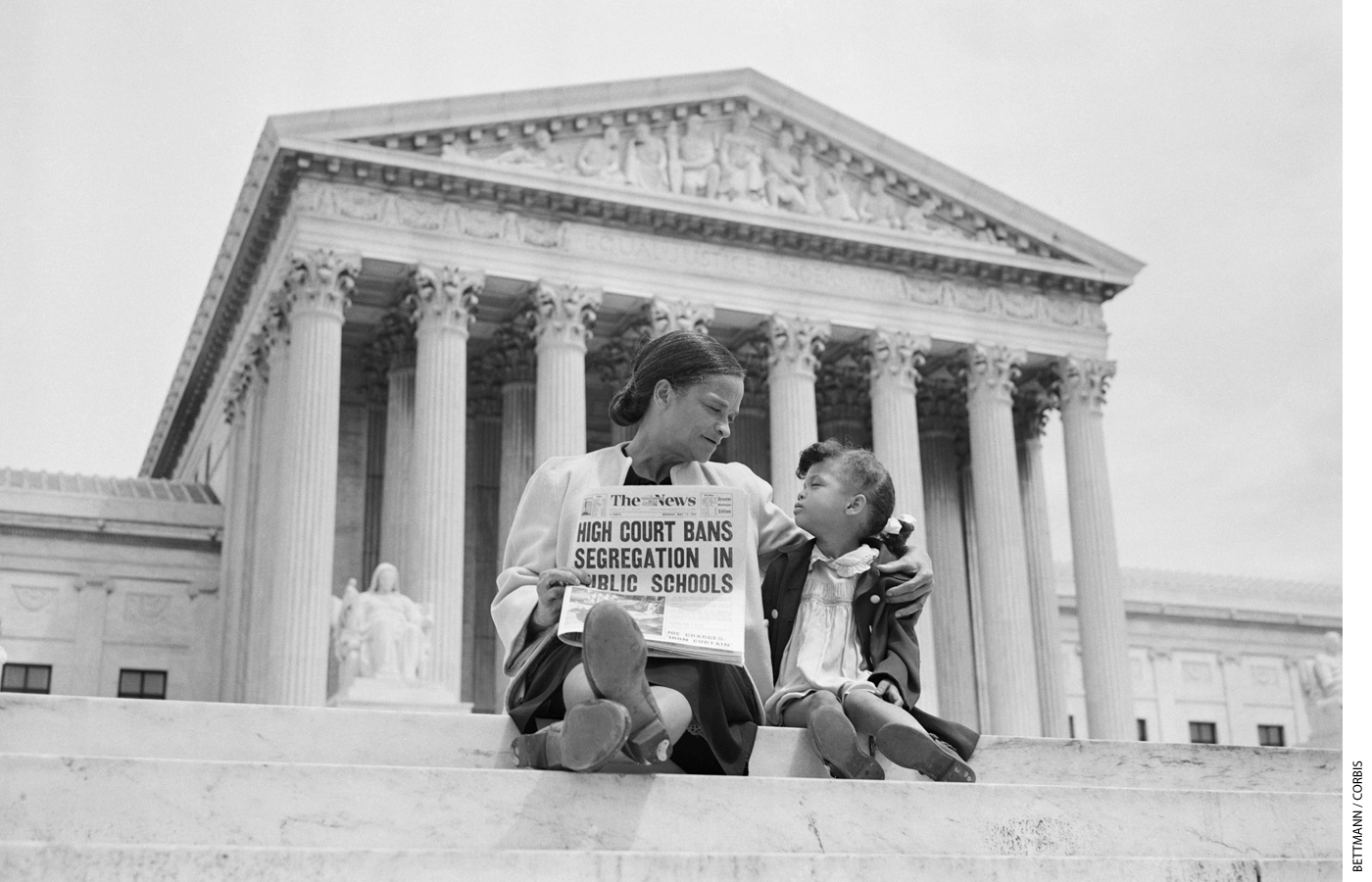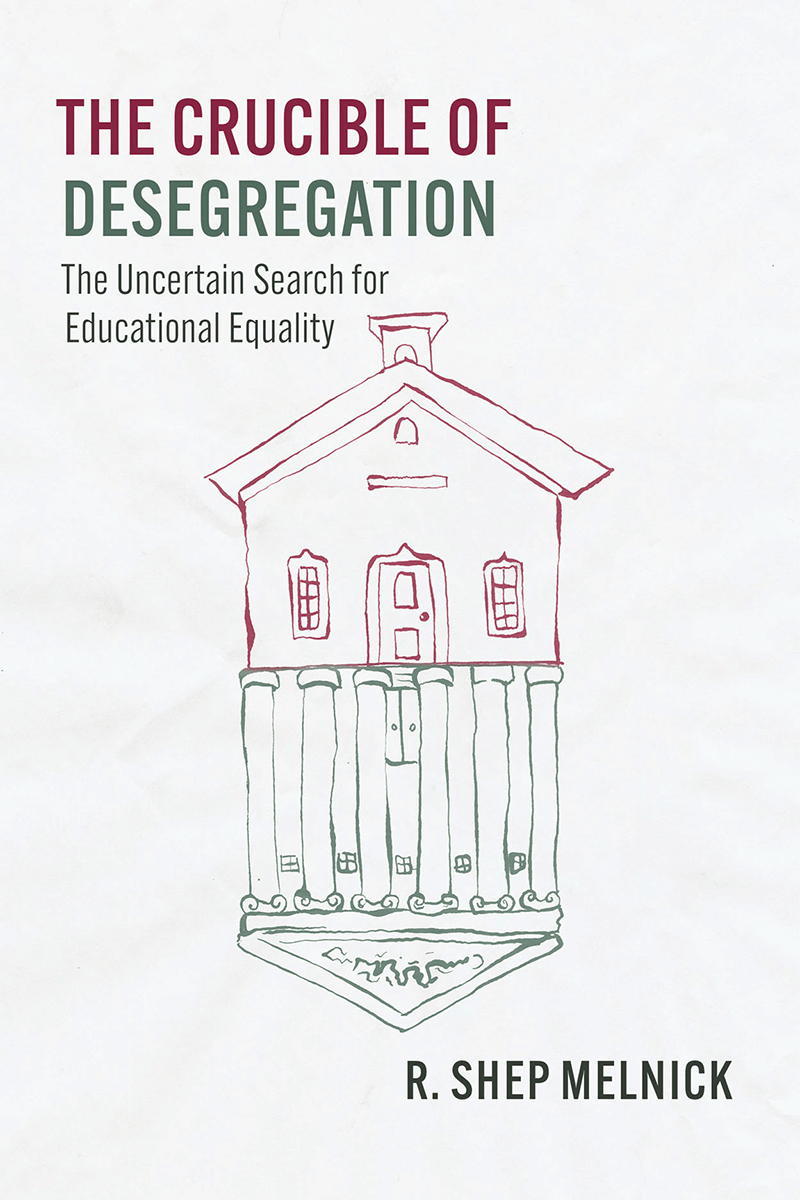
The Crucible of Desegregation: The Uncertain Search for Educational Equality
by R. Shep Melnick
The University of Chicago Press, 2023, $35; 310 pages.
As reviewed by Richard D. Kahlenberg
In this thoughtful but sometimes fatalistic book, Boston College political scientist R. Shep Melnick chronicles the promise and pitfalls of the federal government’s efforts to desegregate American schools and, in so doing, upend a key component of Jim Crow.
Melnick notes that school desegregation stands alone among the various campaigns for equal educational opportunity. While initiatives such as Head Start, federal compensatory spending, support for students with disabilities, programs for English learners, Title IX for women, and the No Child Left Behind Act have sometimes attracted controversy, school desegregation was the most politically explosive effort of all. “Few issues in American politics have been debated so long or so vehemently as school desegregation,” he observes. “From the mid-1960s through the 1970s, school desegregation was the most important and most controversial education issue addressed by the federal government.”
 And while court-ordered school busing has mostly ended, efforts to integrate schools have not. The litigation leading up to the 1954 Brown v. Board of Education decision banning state-enforced separation of white and Black children first came before the U.S. Supreme Court during the administration of Harry S. Truman. Thirteen presidents later, hundreds of small school districts remain under desegregation orders.
And while court-ordered school busing has mostly ended, efforts to integrate schools have not. The litigation leading up to the 1954 Brown v. Board of Education decision banning state-enforced separation of white and Black children first came before the U.S. Supreme Court during the administration of Harry S. Truman. Thirteen presidents later, hundreds of small school districts remain under desegregation orders.
The effort to desegregate has been noble, if often flawed in implementation, Melnick argues. The momentous Brown decision was part of a larger effort to deal with America’s “original sin of racial oppression.” Desegregation had two goals, he says, both worth pursing today: increasing educational opportunity and social mobility, and promoting social cohesion and reducing racial prejudice. School integration, as Justice Stephen Breyer wrote in one opinion, helps foster “the kind of cooperation among Americans of all races that is necessary to make the land of three hundred million people one Nation.”
Federally enforced school desegregation had some clear successes. After a period of lax enforcement in the decade after Brown, the federal government brought dramatic change to the American South. In the 1963–64 school year, only 1.2 percent of southern Black children attended school with some white children. By 1972–73, 91.3 percent did. This period coincided with large increases in test scores for Black students. And when certain school districts abandoned desegregation, such as Charlotte-Mecklenburg, North Carolina, in the 1990s, researchers found a “large and statistically significant increase in crime” among poor Black male students assigned to predominantly minority schools.
If Melnick sees successes in school desegregation, however, he also sees serious flaws in implementation and examples of government overreach.
To begin with, federal judges did a poor job of defining precisely what desegregation meant. Litigants offered two competing ideas: one was procedural (defining desegregation as colorblind assignment), and the other sought results (viewing desegregation as reducing racial isolation in order to improve educational opportunities).
In the early days of desegregation, lawyers for the NAACP Legal Defense and Education Fund advocated colorblindness. “That the Constitution is color-blind is our dedicated belief,” they wrote, arguing that “no State has any authority under the equal-protection clause of the Fourteenth Amendment to use race as a factor in affording educational opportunity among its citizens.”
But over time, Southern politicians exploited that formulaic definition of desegregation to offer “freedom of choice” plans that left schools segregated. The plans were technically colorblind, because Black families in theory could choose to send their children to predominantly white schools. But Black parents who did so often lost their jobs or faced intense social intimidation. Judges concluded that colorblind choice policies were ineffective, since less than one percent of Black children attended school with any white children for nearly a decade after Brown.
Melnick concedes that judges clearly did have to pay attention to racial numbers in order to dismantle Jim Crow. So they began to order busing plans that sought to make all schools in a district reflect the broader racial makeup of the district as a whole. Judges might order, for example, that all of a district’s schools fall within 10 percentage points of the Black or white student population share in the district as a whole. In the Supreme Court, battles erupted over how long such numbers-driven, court-ordered busing plans should remain in place. In the 1990s, the Supreme Court pushed lower courts in the direction of releasing districts from school desegregation orders. And in 2007, the Supreme Court struck down racial integration plans that had been voluntarily adopted by school districts in Louisville and Seattle.
Some Black critics of racial desegregation said the plans were insulting. In one Supreme Court case, Justice Clarence Thomas famously observed, “It never ceases to amaze me that the courts are so willing to assume that anything that is predominantly black must be inferior.” Supporters of integration noted that while there was nothing magical about white pigmentation, because of a history of racial oppression, Black families were much more likely to be poor than white families, and concentrations of school poverty did have an important impact on the ability of students to thrive in a school.
Among the research studies on school integration in recent decades, Melnick notes, “almost all found the socioeconomic composition of the student body more important than the racial mix.” Having a cohort of parents who volunteer strengthens a school community, for example, and parental involvement correlates more highly with socioeconomic status than with race. The importance of socioeconomic factors helps make sense of another key finding that Melnick cites: desegregation in the South resulted in much larger gains in graduation rates and earnings for Black students than desegregation in the North. Because Southern school districts are typically county-based, school desegregation often encompassed affluent white suburbs. In the North, urban school districts often educated students separately from wealthy white suburbs, exempting the latter from desegregation orders. In short, Southern racial desegregation often meant socioeconomic mixing while Northern racial desegregation often did not.
Judicial busing orders, while well intentioned, proved hugely unpopular. In 1973, only 5 percent of Americans supported mandatory busing to achieve racial balance. “Not since Prohibition,” Melnick writes, “had a federal policy provoked such strong opposition.” White families who had resources often fled school desegregation orders by moving their children to a private school or a distant suburb located beyond the area covered by the order. Politicians took note. “Opposition to busing turned Congress from a quiet ally into a vocal critic,” Melnick writes.

Sherrilyn Ifill, president of the NAACP Legal and Education Defense Fund, says opposition to busing reflected “raw racial prejudice and the protection of white supremacy.” Journalist Nikole Hannah Jones, likewise, wrote an article in the New York Times headlined, “Court-Ordered Desegregation Worked. But White Racism Made It Hard to Accept.”
Melnick concedes that white racism was sometimes a driving factor in opposition to busing but suggests that the story is more complicated. In Prince George’s County, Maryland, and Lexington, Kentucky, for instance, Black parents objected to desegregation orders in which coveted seats in magnet schools were reserved for whites. And some parents, both white and Black, did not want their young children on long bus rides to schools that might not provide a strong or welcoming learning environment.
What is to be done? If, as Melnick suggests, integrated schools are better than segregated ones; if achievement is driven more by the socioeconomic status of a student body than its race; if the courts have placed legal limits on using race in student assignment; and if mandatory integration is less likely to gain parental buy-in than voluntary efforts—what about the idea of creating schools of choice that are designed to produce a healthy socioeconomic mix? The question is all the timelier in light of the Supreme Court’s 2023 decision in Students for Fair Admission v. Harvard and the seeming triumph of the colorblind interpretation of Brown.
Today, Melnick notes, some 171 school districts and charter schools, from Raleigh, North Carolina, to Cambridge, Massachusetts, rely on choice and magnet schools to bring about socioeconomic (and thereby racial) integration. These plans seek to reconcile the colorblind and racial isolation interpretations of Brown: they don’t assign students based on race, but because of the relationship between race and class in America, socioeconomic integration plans also produce racial integration. These plans are community-driven rather than court-ordered, so they have local support, which is likely to produce better results. Evidence shows, Melnick says, “that voluntary plans are more effective than those imposed by judicial or administrative fiat.”
Melnick notes in passing that housing segregation is a root cause of school segregation. In a country where 73 percent of schoolchildren attend neighborhood public schools, housing policy is school policy.
I wish Melnick had explored the issue of what to do about housing policies that actively segregate families by class and by race. Polling finds that school integration is popular in concept, but support drops when transporting students is required to achieve it. Housing reform offers important advantages that could integrate neighborhood schools.
Scholars such as Richard Rothstein have outlined the effects of 20th century redlining and racially restrictive covenants. But even to this day, the pervasive use of exclusionary zoning laws, such as bans on multifamily housing, and requirements of very large lot sizes, continue to produce income-based (and therefore racial) segregation. Communities located very close to one another can have dramatically different racial and socioeconomic makeups that are driven in large measure by arcane zoning laws that determine who can live where in America.
Reforms of exclusionary zoning laws have taken off since Minneapolis legalized multifamily housing in 2018. In red states and blue states, conservatives who don’t like government regulation and liberals who don’t like exclusion have come together to reform zoning laws.
Melnick’s even-handed approach to the school desegregation era offers insights into what went right and what went wrong on a very important set of policies. Although the volume is short on solutions, readers can take important lessons about how policymakers today can forge a better future that redeems the promise of Brown.
Richard D. Kahlenberg, a senior fellow at the Progressive Policy Institute and nonresident scholar at Georgetown’s McCourt School of Public Policy, is the author of All Together Now: Creating Middle-Class Schools through Public School Choice (2001) and Excluded: How Snob Zoning, NIMBYism and Class Bias Builds the Walls We Don’t See (2023).
This article appeared in the Winter 2024 issue of Education Next. Suggested citation format:
Kahlenberg, R.D. (2024). A Noble, Flawed Effort: Chronicle of school desegregation since Brown shows policies have been both worthwhile and misguided. Education Next, 24(1), 80-82.


